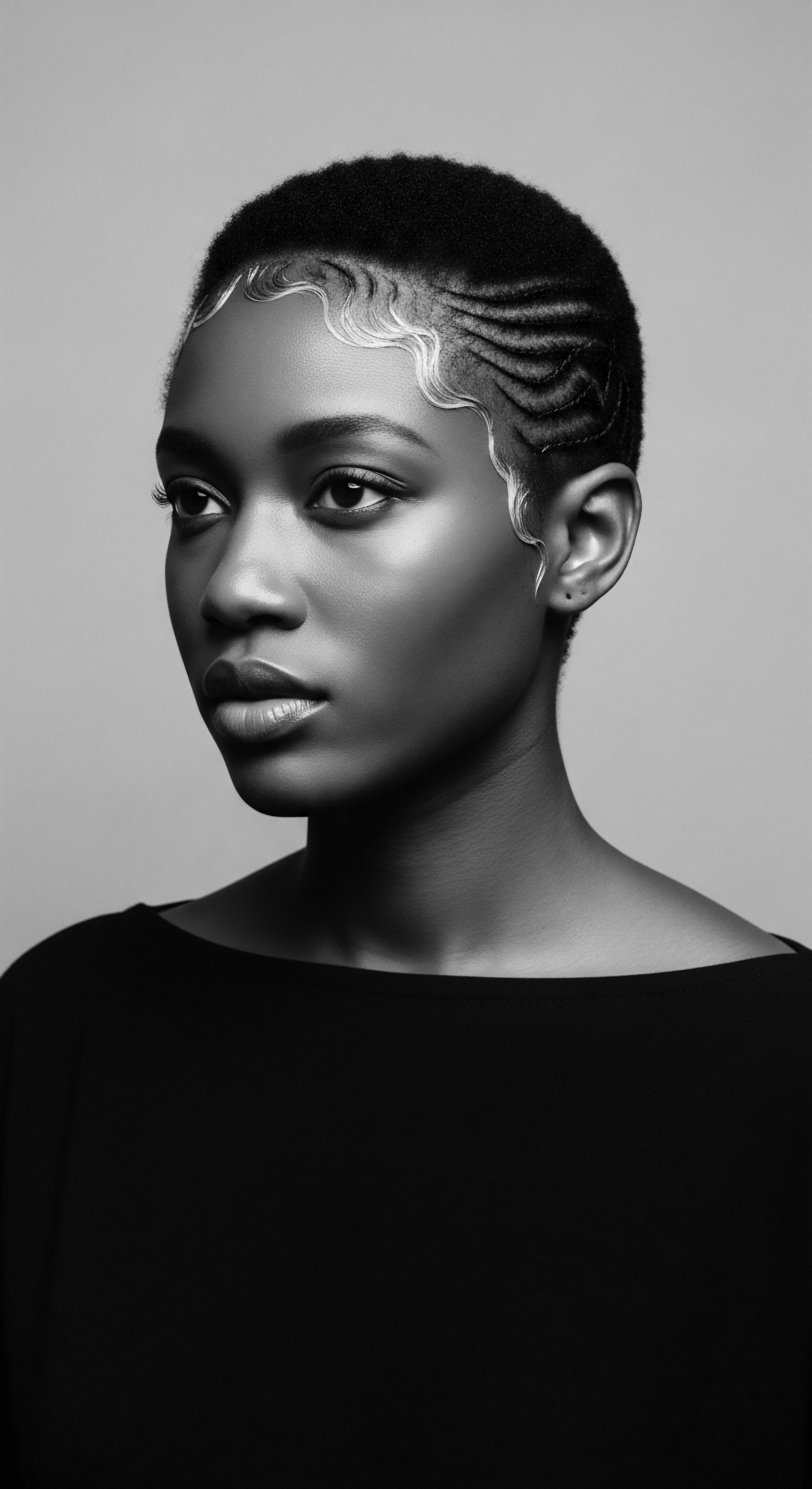
Roots
The story of textured hair, particularly for those of Black and mixed-race ancestry, is not merely a chronicle of appearance. It exists as a living archive, etched into our very being, a profound connection to heritage and the wisdom passed down through generations. To truly understand its resilience, its deep-seated vibrance, we must journey beyond the surface, back to the elemental sources that sustained life and beauty on the African continent. This exploration begins with a look at how the ancestral plate, the bounty of the land, contributed to the strength and unique character of textured hair throughout history.
Consider the intricate coiled strands, each helix a testament to a complex biological design. This hair, by its very nature, possesses a unique architecture, a distinct ellipticity of the follicle and a varying distribution of disulfide bonds. These characteristics contribute to its remarkable spring, its volume, and its sometimes delicate nature, which requires specific care. Ancient African communities possessed an intuitive understanding of this anatomy, long before microscopes revealed cellular structures.
Their knowledge, passed through oral traditions and observation, recognized that strong hair stemmed from a nourished body. The deep connection between internal health and external vitality was a cornerstone of their ancestral wisdom.

The Land’s Generosity and Hair’s Foundation
Across the diverse landscapes of Africa, from the fertile riverbanks to the arid savannas, indigenous food systems provided a wealth of nutrients. These food sources were not random; they were cultivated, gathered, and prepared with an understanding of their life-giving properties. The daily diet of many African peoples was inherently rich in components vital for protein synthesis, cellular regeneration, and systemic well-being—all direct contributors to the health of the hair follicle. Think of the broad spectrum of plant-based foods ❉ indigenous grains like Fonio and Teff, abundant in essential amino acids and micronutrients; a vast array of leafy greens, providing vital vitamins A, C, and E, alongside minerals such as iron and calcium; and tubers, like Yams and cassava, which supplied complex carbohydrates for sustained energy.
Ancestral foodways, rich in diverse nutrients, laid the foundational physiological groundwork for vibrant, resilient textured hair.
Beyond the caloric value, these traditional diets offered micronutrient density that modern diets often lack. For instance, the consumption of indigenous legumes like Cowpeas and Groundnuts delivered protein and zinc, both critical for keratin production, the primary protein component of hair. The vital fatty acids necessary for healthy scalp and hair sheen were derived from sources such as Palm Oil, widely used in West and Central African cuisines, or shea butter, used both in cooking and as a topical treatment.
These internal contributions were not supplemental; they were fundamental to the inherent strength and growth potential of textured hair. This ancient dietary wisdom, attuned to local ecosystems, created a feedback loop ❉ healthy bodies supported healthy hair, which in turn was admired and became a symbol of vitality.

How Did Ancestral Food Systems Support Hair Growth?
The relationship between diet and hair health has been observed for centuries, long before contemporary nutritional science could dissect specific molecular pathways. African food heritage provided a comprehensive nutritional profile that directly supported the various phases of the hair growth cycle. For instance, the anagen, or growth phase, demands a steady supply of protein and energy. Traditional stews and porridges, often containing a blend of grains, legumes, and animal proteins, would have provided this consistent caloric and protein input.
Deficiency in these basic components can lead to premature hair shedding, a condition known as telogen effluvium. The consistent access to nutrient-dense, whole foods in many traditional African societies would have mitigated such deficiencies, promoting sustained, healthy growth.
Moreover, the iron content found in many traditional leafy greens and certain animal proteins (where consumed) played a pivotal part. Iron deficiency is a recognized cause of hair thinning and loss, particularly for those with a genetic predisposition to certain hair types. The consistent intake of iron-rich foods, coupled with vitamin C (from fruits like Baobab or various berries) to enhance iron absorption, provided a robust defense against such hair concerns.
| Traditional Food Category Indigenous Grains (e.g. Fonio, Teff, Millet) |
| Key Nutrients Amino Acids, B Vitamins (Niacin, Riboflavin), Iron, Zinc, Magnesium |
| Traditional Food Category Legumes (e.g. Cowpeas, Groundnuts, Bambara Beans) |
| Key Nutrients Protein, Biotin, Zinc, Iron, Folate |
| Traditional Food Category Leafy Greens (e.g. Amaranth, Bitter Leaf, Okra Leaves) |
| Key Nutrients Vitamins A, C, E, Iron, Calcium, Antioxidants |
| Traditional Food Category Healthy Fats/Oils (e.g. Palm Oil, Shea Butter) |
| Key Nutrients Vitamins A, E, Essential Fatty Acids (Omega-3s, Omega-6s) |
| Traditional Food Category Tubers (e.g. Yams, Cassava) |
| Key Nutrients Complex Carbohydrates, Fiber, Vitamin C, Potassium |
| Traditional Food Category The consistent inclusion of these foods provided a comprehensive nutritional scaffold for vibrant textured hair across generations. |

Ritual
The journey from ancestral sustenance to vibrant hair was not solely a matter of internal physiology; it extended into daily rituals, where the very ingredients that nourished the body were also applied with mindful intention to the hair. The ritualistic aspect of hair care, deeply ingrained in African societies, reflects a profound understanding of holistic well-being. It was during these moments of communal grooming and personal devotion that food heritage transitioned from the cooking pot to the scalp, becoming a tactile extension of ancestral wisdom. These practices shaped how textured hair was cared for, reflecting communal values and individual identities.

Food as Topical Nourishment
The application of food-derived substances to hair and scalp was a common practice across the continent. This was not a distinct separation of “food” and “cosmetic”; often, the same nutrient-rich substances served both purposes, blurring the lines in a way that modern product distinctions rarely do. Oils rendered from indigenous plants, such as Shea Butter from the shea tree (Vitellaria paradoxa) or Palm Kernel Oil, were not only staple cooking fats but also highly valued emollients.
These natural fats, rich in vitamins A and E, provided superior conditioning, sealing moisture into the hair shaft, and imparting a natural sheen that spoke of health. The very act of massaging these oils into the scalp was a ritualistic gesture, stimulating circulation and encouraging growth, while simultaneously delivering vital nutrients directly to the skin and hair follicles.
Consider the widespread use of mucilaginous plants. Okra, for instance, a common ingredient in many West African soups, possesses a natural sliminess. This mucilage, when applied to hair, acts as a natural detangler and conditioner, providing slip and softness without harsh chemicals.
Similarly, the gel from the Aloe Vera plant, prevalent in various African ecosystems, offered soothing and moisturizing properties, calming irritated scalps and hydrating dry strands. These applications represent a practical, intuitive science, born from generations of observation and experimentation within local environments.

Communal Care and Shared Sustenance
Hair care rituals were seldom solitary acts. They were often communal, especially among women, fostering bonds and transmitting generational knowledge. The preparation of hair treatments from food sources was a shared activity, intertwining culinary and cosmetic arts. Grandmothers and mothers taught younger generations how to extract oils, grind herbs, or prepare poultices from local plants.
This collective knowledge ensured the continuity of practices that kept hair strong and vibrant. The shared experience of preparing a Fermented Rice Water Rinse, for instance, a tradition found in various African and diasporic communities, speaks to this interconnectedness. The fermentation process increases the nutrient profile, and the collective effort reinforces communal ties.
Traditional hair care rituals, often communal and rooted in food heritage, offered both physical nourishment and spiritual connection.
The significance of hair in African cultures extended far beyond aesthetics; it was a powerful symbol of status, spirituality, and identity. Intricate hairstyles, often requiring hours of work, were adorned with elements that might also be found in traditional food preparation, such as shells, beads, or even woven fibers. The resilience of the hair, strengthened by generations of internal and external nourishment from food heritage, allowed for these elaborate styles to be maintained, signifying the wearer’s place within the community and their connection to their ancestors.
- Shea Butter ❉ Used both in traditional cooking and as a deeply moisturizing hair sealant. Its rich fatty acid profile helped maintain hair elasticity.
- Palm Oil ❉ A cooking staple and a source of vitamins A and E for topical application, contributing to hair shine and scalp health.
- Okra Mucilage ❉ Applied directly or as part of rinses for natural detangling and conditioning, leveraging its unique texture.
- Aloe Vera ❉ Valued for its soothing and hydrating properties, beneficial for scalp health and moisture retention.

Relay
The continuity of African food heritage, its journey through forced migration and adaptation, has profoundly shaped the resilience of textured hair across the diaspora. This relay of wisdom, from ancient lands to new shores, speaks to an enduring spirit and an unwavering connection to ancestral practices. The challenges faced by diasporic communities often necessitated resourcefulness, leading to the adaptation of food-based hair care with new ingredients, while maintaining the underlying principles of nourishment and reverence. This section explores how scientific understanding now illuminates the wisdom of these historical practices, demonstrating the deep interplay between diet, genetics, culture, and hair health.

Dietary Shifts and Hair Resilience Across Eras
The transatlantic slave trade presented an immense disruption to African food systems and, consequently, to the nutritional foundation supporting hair health. Enslaved Africans were often denied access to the diverse, nutrient-rich foods of their homelands, forced instead onto meager, monotonous diets. Despite these horrific circumstances, they displayed remarkable adaptability, cultivating gardens with familiar seeds smuggled from Africa or adopting new local plants and preparing them with ancestral culinary methods.
This perseverance in maintaining some semblance of traditional foodways, even in the face of deprivation, became a crucial element in sustaining their health, including the vitality of their hair. The ability to source and prepare nutrient-dense foods, however limited, contributed to mitigating severe deficiencies that would have otherwise led to widespread hair loss and fragility.
Consider the impact of the Columbian Exchange on the food landscape of the Americas. While devastating in many ways, it also led to the introduction of new crops that some enslaved Africans skillfully incorporated into their diets and hair care. For instance, the humble sweet potato, rich in beta-carotene (a precursor to vitamin A), became a staple, its nutritional contribution undoubtedly aiding in cellular growth and scalp health. The ingenious ways African peoples adapted their food heritage, cultivating new crops with old wisdom, served as a quiet act of defiance and survival, a silent testimony to the strength of their traditions.

The Science of Ancestral Nutrition for Hair
Modern nutritional science provides validation for the intuitive practices of our ancestors. The complex array of vitamins, minerals, and macronutrients found in traditional African diets are now recognized as essential for the intricate biochemical processes involved in hair growth and strength. For example, the high consumption of complex carbohydrates from tubers and whole grains provided sustained energy for keratin synthesis. Keratin, the primary structural protein of hair, requires a continuous supply of amino acids, which were abundantly available from the diverse protein sources in traditional diets.
Contemporary science validates the profound efficacy of ancestral food practices in supporting textured hair through targeted nutritional input.
A specific historical example demonstrating the direct influence of food heritage on hair strength comes from West African communities, where the regular consumption of fish and nuts provided essential fatty acids and protein. A study on dietary patterns in traditional African populations often highlights the intake of polyunsaturated fatty acids (PUFAs) from plant sources like groundnuts and palm oil. These PUFAs are crucial for maintaining the integrity of cell membranes, including those of hair follicles, contributing to both hair strength and scalp health (Abioye & Oyewole, 2017). This traditional dietary pattern, passed through generations, naturally provided the building blocks for resilient hair.
Furthermore, the fermentation techniques common in many African food traditions – think of fermented porridges or beverages – enhanced nutrient bioavailability. Fermentation increases B vitamins, like biotin, which plays a direct part in hair follicle health and the strengthening of keratin structures. The consistent, bioavailable nutrient intake from these ancient food preparation methods acted as a natural internal conditioner, strengthening hair from the very root.
| Ancestral Practice/Food Group Consumption of Indigenous Grains & Legumes |
| Historical Application/Benefit Provided consistent energy, muscle strength; sustained vital functions. |
| Modern Scientific Link to Hair Rich in amino acids (protein), B vitamins, iron, and zinc, all critical for keratin production and hair growth cycle. |
| Ancestral Practice/Food Group Use of Natural Oils (e.g. Palm, Shea) |
| Historical Application/Benefit Used for cooking and topical applications, imparted sheen, kept skin supple. |
| Modern Scientific Link to Hair High in vitamins A & E, and essential fatty acids. Antioxidant properties protect scalp cells; fatty acids maintain hair lipid barrier. |
| Ancestral Practice/Food Group Incorporation of Leafy Greens & Colorful Fruits |
| Historical Application/Benefit Regular part of diet, believed to cleanse and invigorate. |
| Modern Scientific Link to Hair Sources of vitamins A, C, E, and antioxidants. These combat oxidative stress, support collagen production around follicles, and aid iron absorption. |
| Ancestral Practice/Food Group Fermented Foods & Beverages |
| Historical Application/Benefit A method of preservation, believed to aid digestion. |
| Modern Scientific Link to Hair Increases bioavailability of micronutrients, especially B vitamins (like biotin), which directly support hair follicle cell metabolism and keratin structure. |
| Ancestral Practice/Food Group The continuum of African food heritage provides a powerful template for understanding hair strength through a lens of both deep cultural wisdom and validated biological principles. |
The legacy of these nutritional strategies extends to the present. Many communities across the diaspora continue to prioritize nutrient-dense, plant-rich diets, not only for overall health but also recognizing their hair-strengthening properties. This continuity speaks to the inherent effectiveness of these ancestral food systems and their deep integration into cultural identity and well-being.

Reflection
The story of textured hair, as it intertwines with African food heritage, reveals itself as a narrative of profound resilience and enduring wisdom. It speaks to a time when nourishment, both internal and external, was a symbiotic dance with the land, a conscious recognition of the body as a whole system. Each coil, each twist, carries within it the echoes of ancestral plates, of hands that tilled the soil, of the sun that ripened the crops, and of the communal spirit that shaped identity. The strength of textured hair, far from being a mere aesthetic attribute, stands as a testament to the life-sustaining practices that transcended generations, migrations, and challenges.
The ‘Soul of a Strand’ ethos, for Roothea, is precisely this recognition ❉ that our hair is a living, breathing archive. It holds the memories of the nutrients gleaned from millet and yams, the protective shield offered by shea and palm oils, and the collective care shared within communities. Understanding how African food heritage bolstered hair strength is not a glance backward into a dusty past.
It is, rather, an illumination of a living legacy, a vibrant current that flows from ancient culinary traditions into contemporary self-care. It invites us to honor the deep lineage of wisdom that connects our current understanding of hair health to the ingenious survival and flourishing of those who came before us, solidifying the idea that true beauty begins from within, nourished by the earth and carried forward by heritage.

References
- Abioye, I. A. & Oyewole, O. E. (2017). Dietary patterns and nutritional status of African populations. African Journal of Food Science, 11(5), 159-170.
- Aluko, R. E. (2012). Functional Food and Health. InTech.
- Asiedu, J. J. (2016). Processing Tropical Crops ❉ A Technological Approach. Palgrave Macmillan.
- Berres, A. (2018). African American Hair ❉ A History. NYU Press.
- Fadahunsi, A. (2011). Traditional African Medical Plants ❉ Properties and Uses. Springer.
- Gwambe, M. (2015). Indigenous African Foods ❉ A Cultural and Nutritional Perspective. University of KwaZulu-Natal Press.
- Kittles, R. A. & Weiss, K. M. (2019). African Americans and the New Biology. Harvard University Press.
- Opare-Obeng, S. (2010). The African Food Crisis ❉ Lessons for the Future. Ohio University Press.
- Sowunmi, F. (2007). Ethnobotany of West Africa ❉ Practices and Medicinal Plants. CRC Press.
- Williams, L. B. (2020). Hair Story ❉ Untangling the Roots of Black Hair in America. St. Martin’s Press.
